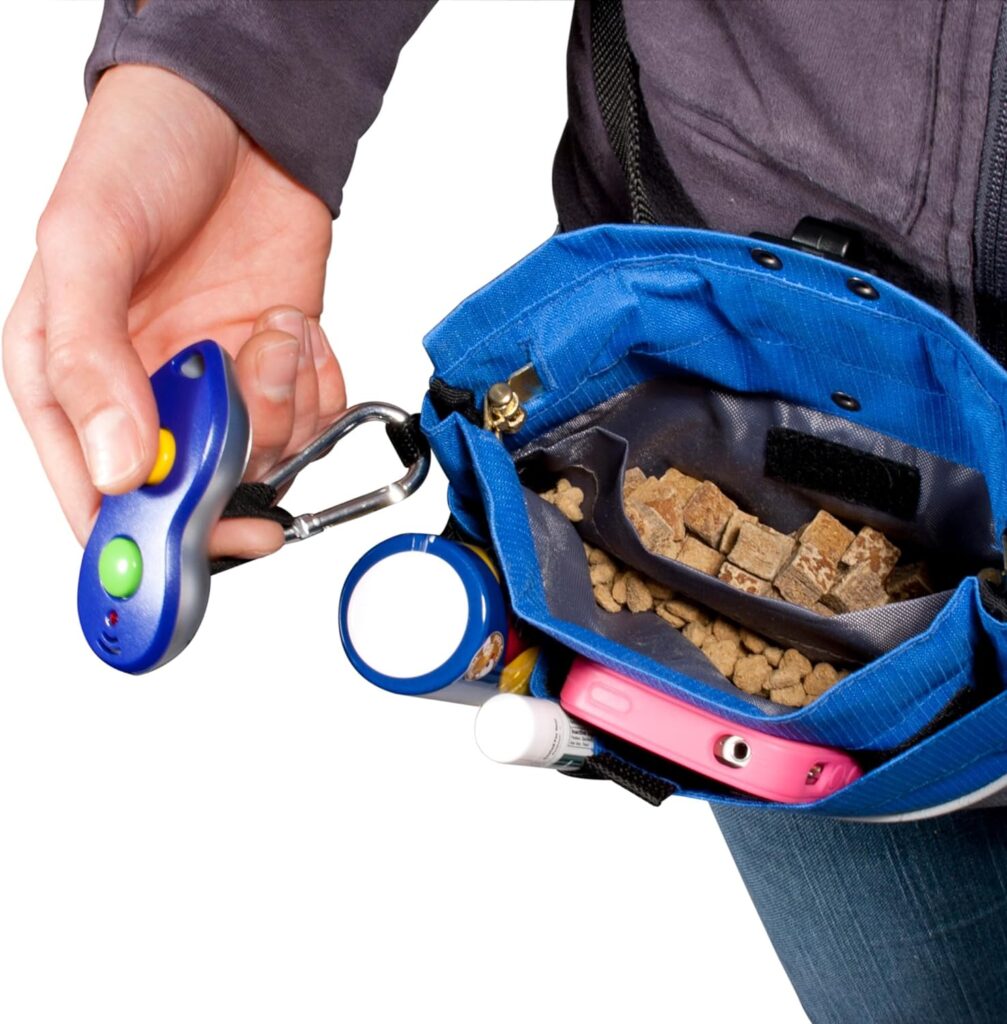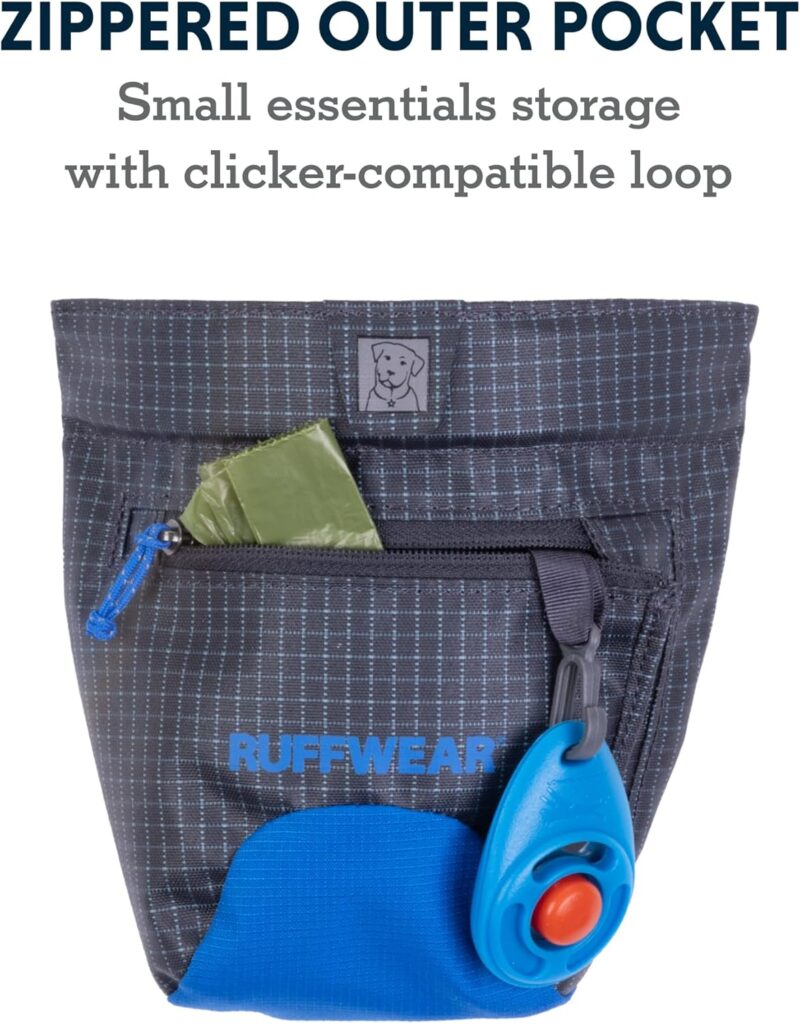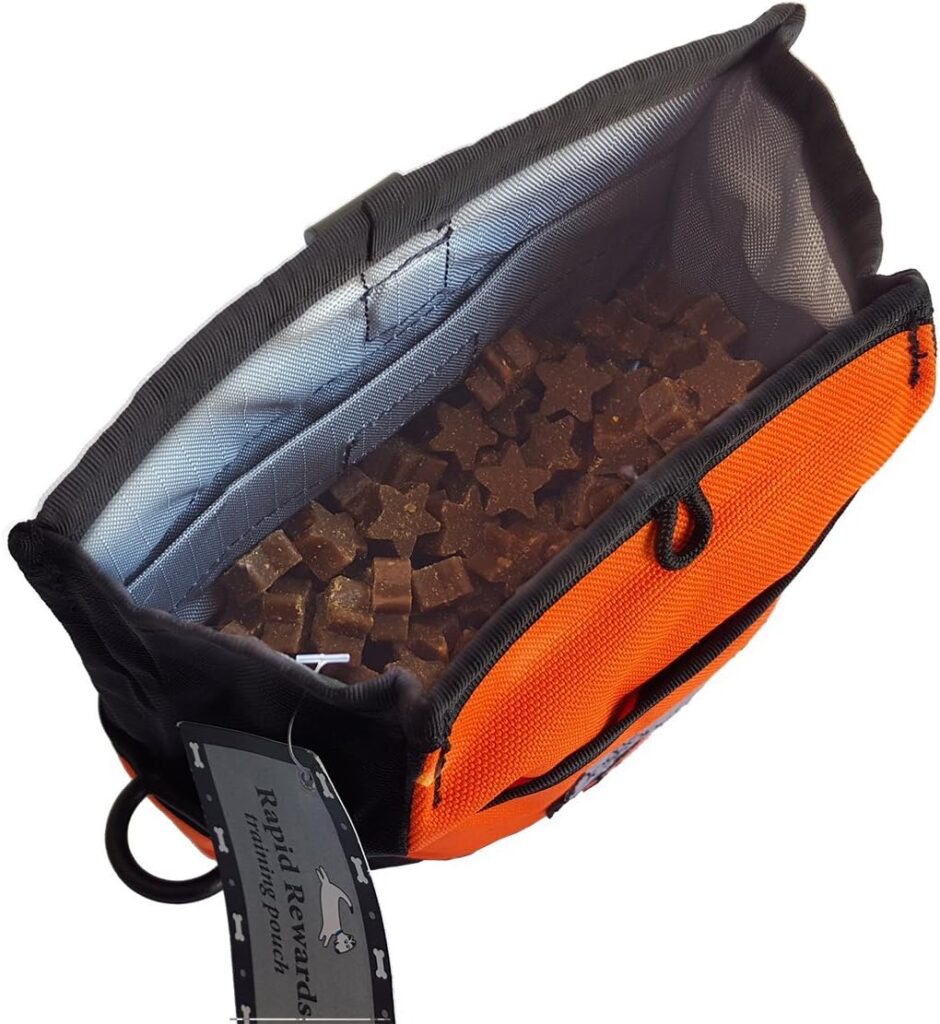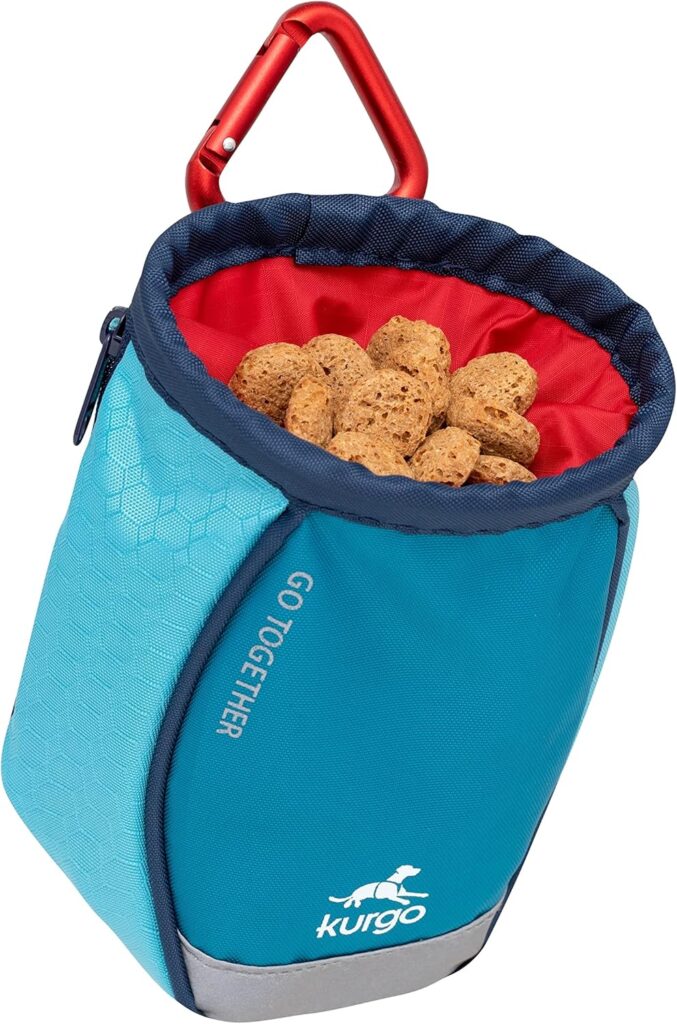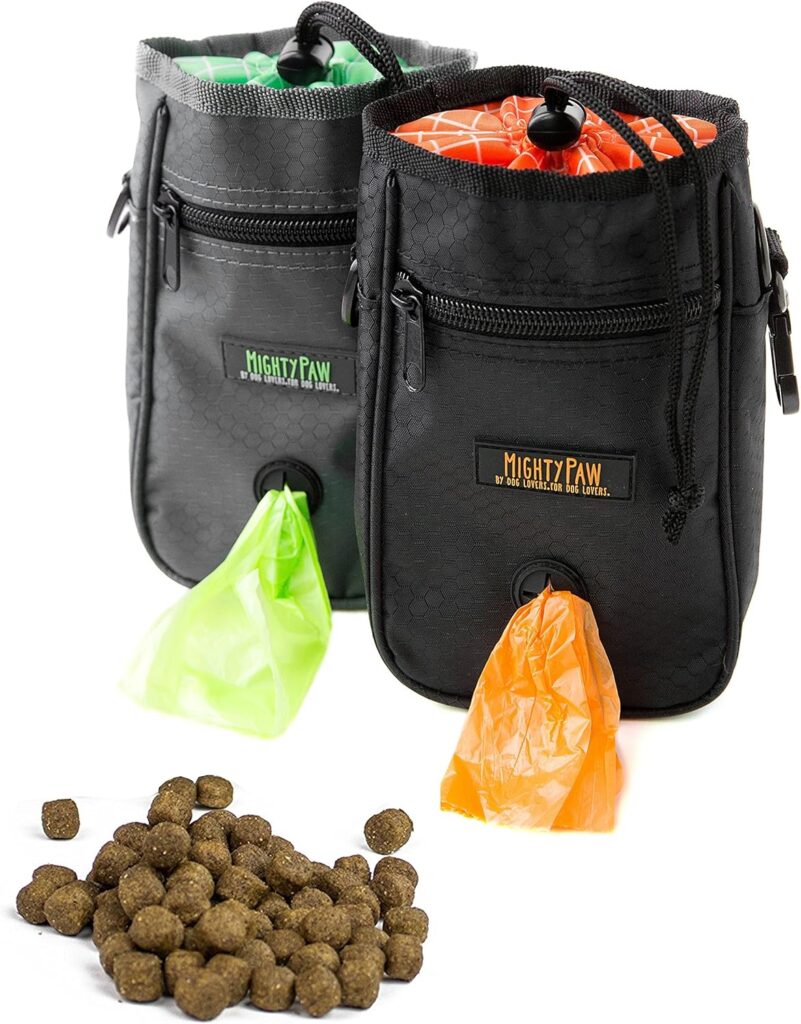As an Amazon Associate, I earn commission from qualifying purchases.
Professional dog trainers will say that having the right tools can make or break a training session. One often overlooked but crucial item is a good treat pouch.
A well-designed treat pouch can significantly boost your training efficiency and effectiveness.
This is your comprehensive guide to the top dog training treat pouches for effective reward-based training, including valuable tips to help you make the most of your training sessions.
Why a Quality Treat Pouch Matters
A quality treat pouch allows for quick and easy access to rewards, keeping your hands free for clickers, leashes, or other training tools. It helps maintain treat freshness and prevents them from getting crushed or melting in your pocket.
A well-designed pouch makes your training sessions more organized and efficient, allowing you to focus on your dog’s progress as opposed to fumbling for treats.
Top Picks for Dog Training Treat Pouches
The PetSafe Treat Pouch Sport is a versatile option perfect for active trainers. It’s wide opening allows for easy access to treats, while the drawstring closure keeps them secure when not in use.
The water-resistant material is ideal for outdoor training sessions, making it perfect for those unpredictable weather days.
Key Features:
- Wide opening for easy access
- Drawstring closure for security
- Water-resistant material
- Built-in waste bag dispenser
The built-in waste bag dispenser is particularly handy for walks and outdoor training, allowing you to maintain a clean environment while rewarding your dog. This feature has saved me countless times during long training sessions in parks or other public spaces.
For trainers who prioritize durability, the Ruffwear Treat Trader is an excellent choice. Made from tough, water-resistant fabric, this pouch can withstand rough use and outdoor adventures.
The magnetic closure is a standout feature, allowing for one-handed operation during training, which is particularly useful when you’re juggling many tasks.
Key Features:
- Durable, water-resistant fabric
- Magnetic closure for one-handed operation
- Ergonomic design for comfort
- Attachment options for versatile wear
The Treat Trader’s ergonomic design makes it comfortable to wear for extended periods, which is crucial for longer training sessions or all-day outings with your dog.
<<< Check it out now on Amazon >>>
3. Doggone Good Rapid Rewards Deluxe Training Bag
This pouch is a favorite among professional trainers because of it’s spacious main compartment and many pockets for storing various items. The Rapid Rewards Deluxe bag features a unique hinge opening that stays open for quick treat access but closes securely when not in use, preventing accidental spills.
Key Features:
- Spacious main compartment
- Multiple pockets for organization
- Unique hinge opening
- Secure closure
The extra pockets are convenient to carry different types of treats for varying reward levels during training. This allows adjustment to the value of the reward based on the difficulty of the task or the level of distraction in the environment.
For example, one might use regular kibble for easy tasks in a low-distraction environment but switch to high-value treats like small pieces of cheese or cooked chicken for more challenging behaviors or when working in a distracting setting.
<<< See the features of the Doggone Good Training Bag and check pricing on Amazon now >>>
4. Kurgo Go Stuff It Dog Treat Bag
The Kurgo Go Stuff It bag stands out with its roll-top closure, which allows you to adjust the opening size based on the treats you’re using. It’s made from rugged, machine-washable fabric and includes a carabiner for easy attachment to your belt or leash, making it a versatile option for various training scenarios.
Key Features:
- Adjustable roll-top closure
- Rugged, machine-washable fabric
- Carabiner for easy attachment
- Reflective strip for visibility
The reflective strip on this pouch adds an extra safety element for evening training sessions, making it an excellent choice for those who often train in low-light conditions. This feature is particularly useful during early morning or late evening training sessions, especially in urban areas with limited lighting.
<<< See the Kurgo Go Stuff It Dog Treat Bag in action here >>>
If you’re looking for a compact option, the Mighty Paw Treat Pouch is worth considering. Despite its small size, it features a divider in the main compartment, allowing you to carry two types of treats.
The silicone lining makes it easy to clean and helps keep treats fresh, which is essential for maintaining your dog’s interest during training.
Key Features:
- Compact design
- Divider for many treat types
- Silicone lining for easy cleaning
- Built-in poop bag dispenser
Check out the built-in poop bag dispenser on Amazon. It is a thoughtful addition for on-the-go training, allowing you to maintain a clean environment without carrying an additional bag or dispenser. This feature is a game-changer during long training walks, as it eliminates the need for many accessories.
Training Tips for Effective Treat Pouch Use
Now that we’ve covered some top dog training treat pouches for reward-based training, let’s talk about how to use them effectively in your training sessions. These tips will help you maximize the benefits of your chosen treat pouch and improve your overall training efficiency.
Proper Placement
Where you wear your treat pouch can significantly impact your training efficiency. Trainers recommend wearing it on your hip or lower back for easy access without interfering with your movements.
Experiment with different positions to find what works best for you and your dog.
Some trainers prefer to wear their pouch on the front for quicker access, while others find it more comfortable on the side or back. For example, wearing the pouch on the right hip allows for the quickest access while keeping the left hand free for leash control or hand signals.
Treat Selection
Choosing the right treats for your training sessions is crucial. Small, soft, and highly appealing treats work best.
These should be easy to dispense quickly and something your dog can consume rapidly without interrupting the training flow.
Avoid treats that are too large, crumbly, or need extensive chewing, as these can slow down your training sessions.
One might cut larger treats into smaller pieces to extend the supply and prevent overfeeding during training sessions. This also allows me to more frequent rewards without overloading the dog with calories.
Some go-to training treats include small pieces of cooked chicken, cheese cubes, and commercial soft training treats.
Treat Delivery Technique
Practicing your treat delivery technique is essential for smooth and effective training sessions. The faster you can reward your dog after a desired behavior, the more effective your training will be.
Develop a fluid motion that allows you to grab a treat and deliver it to your dog in one swift movement.
This skill takes practice but will significantly improve your timing and, so, your training results. It’s helpful to practice your treat delivery technique without your dog present at first.
This allows you to develop muscle memory and improve your speed and efficiency without the added pressure of managing your dog’s behavior.
Varying Reward Levels
Using your treat pouch to carry different types of treats with varying value to your dog allows you to adjust the reward level based on the difficulty of the task or the distractions present. This technique, known as differential reinforcement, can significantly enhance your training effectiveness.
For example, you might use regular kibble for easy tasks in a low-distraction environment, but switch to high-value treats like small pieces of cheese or cooked chicken for more challenging behaviors or when working in a distracting setting. Some top dog training treat pouches offer multiple pockets for separating lower-value treats and high-value treats, allowing for quick transitions between reward levels.
Cleaning and Maintenance
Regular cleaning of your treat pouch is essential to prevent odor buildup and maintain hygiene. Most pouches are machine washable or can be easily wiped clean.
Establish a routine for cleaning your pouch, perhaps after each training session or at least once a week, depending on how often you use it.
A clean treat pouch lasts longer and helps keep treats fresh and appealing to your dog, which is crucial for maintaining their motivation during training sessions. Make it a habit to empty and clean your treat pouch after each training day, ensuring it’s always ready for the next session.
Integrating Treat Pouches into Your Training Routine
A treat pouch is more than just a container – it’s a vital tool in your training arsenal. By having treats readily available, you can seize teachable moments throughout the day, reinforcing good behaviors as they occur naturally.
This approach to training, often called “capturing,” can be incredibly effective in reinforcing desired behaviors in real-life situations.
Consistency is crucial in dog training. Always having your treat pouch with you encourages consistent rewarding, which leads to faster and more reliable learning for your dog.
It also helps you maintain a positive training mindset, as you’re always prepared to reinforce good behavior.
As behaviors become more established, gradually reduce your reliance on the treat pouch, but keep it handy for occasional reinforcement and new skill training. This gradual reduction helps transition your dog from constant treat rewards to more intermittent reinforcement, which can actually strengthen the learned behaviors.
Advanced Training Techniques with Treat Pouches
Once you’ve mastered the basics of using a treat pouch for reward-based training, you can incorporate more advanced techniques to further enhance your dog’s learning experience.
Variable Reinforcement Schedules
As your dog becomes more proficient in a behavior, you can start using a variable reinforcement schedule. This means not rewarding every single correct response, but instead rewarding randomly.
This unpredictability can actually make the behavior stronger and more resistant to extinction.
Your treat pouch plays a crucial role here, as it allows you to always be prepared to reward, even if you don’t do so every time. I’ve found that this technique is particularly effective for maintaining already learned behaviors and keeping my dogs engaged in training sessions.
Premack Principle
The Premack Principle suggests that more likely behaviors can be used to reinforce less likely behaviors. In other words, you can use your dog’s desire to perform a favorite activity as a reward for a less exciting task.
Your treat pouch can come in handy here too – you can use it to store small toys or other non-food rewards that your dog finds motivating. For example, you can carry a small tennis ball in the treat pouch for dogs who are highly play-motivated. After completing a less exciting task, like a long “stay,” you can reward them with a quick game of fetch.
Behavior Chains
A behavior chain is a series of behaviors performed in sequence, with the final behavior being rewarded. Your treat pouch allows you to reward the entire chain at the end, reinforcing the sequence as a whole. This technique is particularly useful for complex tasks or routines.
For instance, when teaching a dog to retrieve an item and bring it back, you might reward only when the dog completes the entire sequence: going to the item, picking it up, returning to you, and releasing it into your hand. The treat pouch allows you to have the reward ready at the end of this chain, reinforcing the entire sequence of behaviors.
Troubleshooting Common Treat Pouch Issues
Even with the best treat pouches, you might encounter some challenges. Here are some common issues and how to address them:
Treat Accessibility
If you’re having trouble quickly accessing treats, try practicing your treat retrieval technique without your dog present. This allows you to develop muscle memory and improve your speed and efficiency.
Think of training your dog like a baseball player practicing their swing. Just as a player spends hours in the batting cage refining their technique, you should dedicate a few minutes each day to practicing treat retrieval and delivery. This daily repetition helps build the precision and consistency needed for success.
Treat Freshness
Keeping treats fresh is crucial for maintaining your dog’s interest and motivation. If treats are becoming stale or losing their appeal, consider using a pouch with a tighter seal or switching to treats with a longer shelf life.
Alternatively, you could prepare fresh treats more often in smaller batches.
Silicone treat pouches or those with airtight closures can significantly extend the freshness of treats. For longer training sessions or full-day outings, I often bring a small cooler pack with additional fresh treats to replenish my pouch throughout the day.
Overreliance on Treats
If you find your dog only responds when they know you have treats, start varying your reinforcement schedule and incorporating other forms of reward, such as praise or play. Your treat pouch can still be useful here for carrying toys or as a bluff – your dog doesn’t always need to know whether you actually have treats or not.
I sometimes use a technique I call the “phantom treat,” where I go through the motions of reaching into my treat pouch, but instead offer enthusiastic praise or a game of fetch. This helps maintain the association between the treat pouch and rewards, even when food isn’t always provided.
Frequently Asked Questions
What is the best treat pouch for effective dog training?
The best treat pouch depends on your specific needs and training style. Popular options include the PetSafe Treat Pouch Sport for it’s versatility, the Ruffwear Treat Trader for durability, and the Doggone Good Rapid Rewards Deluxe Training Bag for it’s spacious design and many pockets.
How do I choose a dog treat pouch?
When choosing a dog treat pouch, consider factors such as size, durability, ease of access, closure type, and additional features like waste bag dispensers or extra pockets. Think about your training environment and personal preferences to find the best fit for your needs.
Can I use a regular bag instead of a treat pouch for dog training?
While you can use a regular bag, dedicated treat pouches are designed specifically for easy treat access and often include features that make training more efficient, such as secure closures and hands-free wear options.
How often should I clean my dog treat pouch?
It’s recommended to clean your treat pouch at least once a week, or more often if you use it daily. Regular cleaning helps maintain hygiene and prevent odor buildup.
What types of treats work best in a treat pouch?
Small, soft treats that don’t crumble easily work best in treat pouches. These allow for quick delivery and easy consumption by your dog without interrupting the training flow.
How can I prevent treats from getting stale in my pouch?
To prevent treats from getting stale, use pouches with secure closures, avoid overfilling the pouch, and consider using airtight containers to store treats when not in use. Some trainers also rotate treats often to maintain freshness.
Are treat pouches necessary for positive reinforcement training?
While not absolutely necessary, treat pouches significantly enhance the efficiency and effectiveness of positive reinforcement training by providing quick and easy access to rewards.
Can treat pouches be used for other items besides food?
Yes, many trainers use treat pouches to carry small toys, clickers, or other training tools in addition to or instead of food treats.
How do I teach my dog not to jump for the treat pouch?
To prevent jumping, teach your dog that calm behavior earns rewards. Practice having the pouch on without giving treats, and only reward when your dog is calm and not focused on the pouch.
What’s the difference between a treat pouch and a bait bag?
While the terms are often used interchangeably, bait bags are typically larger and designed for hunting or fishing. Treat pouches are specifically designed for dog training with features like easy-access openings and secure closures.
Key Takeaway
A well-chosen treat pouch, combined with proper training techniques, can significantly improve the efficiency and effectiveness of your dog training sessions, leading to faster learning and a stronger bond between you and your dog. By adopting a quality treat pouch and mastering it’s use, you’ll be well-equipped to tackle any training challenge and help your dog reach their full potential.

